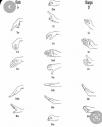Ward hand signals
-
Are there any practitioners of the Ward Method on this forum who can tell me whether Justine Ward designated a hand signal for "te"? I looked through the entire Volume I, and went through the Ward I training, but cannot find any mention of such a hand signal. (If it were up to me, I would turn the position of the hand so that the wrist is still bent, but the palm is facing the teacher instead of the floor. But I'm not Justine Ward, obviously.) Looking forward to any thoughts. TIA.Thanked by 1Bri
-
Here are all the hand symbols for Flats. Orff and the Kodaly method use them as well (i googled). I recall learning them in Orff class in grade 3, but only know them when I see them.

 2C2FA736-F1BB-4387-B0D7-8AFAB3A8671D.jpeg717 x 896 - 121K
2C2FA736-F1BB-4387-B0D7-8AFAB3A8671D.jpeg717 x 896 - 121K -
Those are indeed the Kodaly hand symbols, but that's a different system than the Ward Method, which mostly uses a flat hand placed at different points on the body (from the waist all the way to above the head) to indicate pitch-level by the height of the hand on (or above) the body. It's quite different from the Kodaly symbols, wherein each note along the scale has its own unique hand sign; the Ward method does not employ this signaling technique.
-
Well, then why not just teach the Kodaly method which children will get more use out of knowing solfege along with all the flats and sharps? Why not set them up to be able to SightSing regular notation?
-
The Ward Method of music education is a very comprehensive system which teaches children how to feel and count rhythm, conduct, sight sing, sing with a pure tone, and read both western and chant notation. If you are not familiar with it, it's worth having a look. The Ward hand signals, though basic, are quite helpful because of their spatial relevance with the body, and recognition of half/whole steps. Students with whom I have worked have found the Ward hand signals to be a bit easier to learn than some of the other hand signal systems. I'm only using the hand signals for warmups to get modal tonality established, so there is no need for any accidentals other than "te".Thanked by 1Elmar
-
Te isn't taught in Ward 1 so the signal wouldn't be in there, could you use the tune transposed to Re or Sol (for a minor or major scale w flat 7 between do re or fa sol?Thanked by 1AngelaR
-
Thank you, perg1224. I looked through Ward 2 and don't see te in that volume either. Did she teach hand signals for the accidentals at all, or did she move away from hand signals by the time she started teaching accidentals? Would you happen to know?
-
I don't know (I won't take Ward 2 till summer). Based on my overall view of the curriculum, though I would think she moves away from the measuring gesture. I'll check with my mentor and see what she says.
-
There is no Ward Method "Te" hand gesture (Ward term: "Measuring Gesture"), nor any other - only diatonic notes Do through Ti. In my years of teaching the Ward Method, one young person suggested (how they love to do that!) using the "Ti" gesture but pointing away (out) from the body, and it works just fine.
-
To complement Nisi's response, I'd add that my mentor said she uses Kodaly or Curwen when necessary for accidentals (usually well after kids have cleared Ward 1, I presume)
-
I'm not sure why, but I make a clawed hand at the Ti position for Te. I think I just made it up.
Welcome to the MusicaSacra Forum!
To participate in the discussions on Catholic church music, sign in or register as a forum member, The forum is a project of the Church Music Association of America.
Categories
- All Discussions21,158
- General Music Discussion8,236
- Job Openings204
- Management of Music Programs850
- Choral Matters533
- Church Documents and Rubrics526
- CMAA Notes304
- Events720
- For Newcomers: Read First26
- Sacred Polyphony547
- Hymnody872
- Gregorian Chant: General2,702
- ↳ Graduale Romanum and Liber Usualis368
- ↳ Graduale Simplex60
- ↳ Semiology63
- Vernacular Plainsong696
- Anglican Use and Anglican Chant68
- Organ, Other Instruments and Repertoire435
- New Composition/Works in Progress1,295
- Recordings234
- Music for Hispanic Ministry159
- Music Education: Children211
- Music Education: General222
- News Items245
- Positions Wanted2
- General Discussion: Catholicism740
- Amusements177
- General Discussion1,035
- Opinions119


